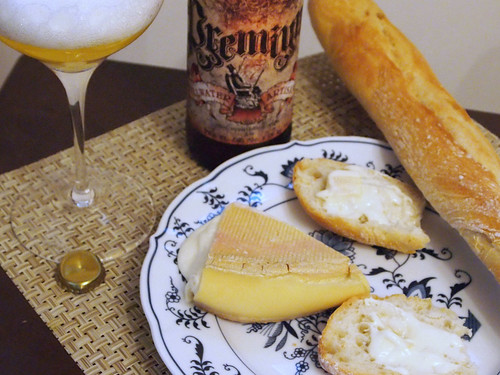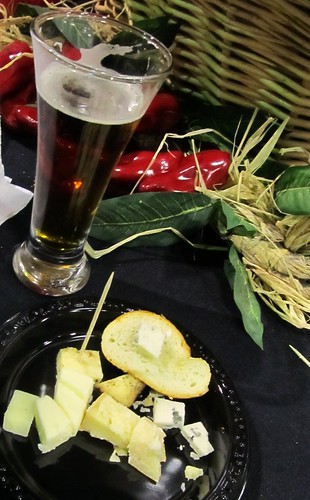Enjoying cheese and beer together. Oh my!
That's an accepted morsel of wisdom these days to many of the American 'craft' beer zeitgeist. Thus it might come as a surprise that beer-with-cheese as a culinary concept had until only recently been poo-pooed by foodies in the U.S. (who somehow ignored the ubiquitousness of beer-with-pizza). Silly, considering that in other parts of the world, beer-with-cheese has long been a staple of food culture.
Ten years ago, a reporter for the Baltimore Sun wrote an article on the superiority of beer over wine when matching with cheese. I've posted it below. Was it because she quoted me?
Before you read that, consider this. In that same year, 2005, the vino-zeitgeitist Wine Spectator wrote this:
- "Cheeses fight with dry wines."
- And this: "Many people find that the moldy flavors of these cheeses fight with dry wines. Their creaminess is especially tough on reds. Sweet wines are the answer."
- And this, about washed-rind cheeses: "As much fun as these cheeses are to eat, in most cases only very sweet or fortified wines can hold their own against them."
I will: "Try beer!"
Crafty Combo! Artisanal beer makes a better match with cheese than many wines.
A prize-winning soft chevre from Quebec.By Stephanie Shapiro
A buttery California brie.
A semi-firm, washed-rind cheese and a potent blue, both from Wisconsin.
Like fragrant, edible jewels, the cheeses nestle on a rectangular ceramic platter. Four different bottles of craft beer are arranged behind them.
The delectable still life has been assembled by Susan Scovell, cheesemonger at the Wine Source in Hampden [neighborhood in Baltimore, Maryland], as an introduction to the ambrosial pleasures of pairing cheese and beer.
The two farmhouse products that have long been a part of traditional meals in Europe, including the venerable ploughman's lunch, are being reinvented with inspired finesse. The resulting proliferation of artisanal cheeses and craft beers has brought forth boundless possibilities for pairings in restaurants, gourmet shops, homes and even wine bars.
Scovell initiates a novice with a modest selection so as not to overwhelm the palate. "Think in terms of contrast or similarities when you pair cheese and beer," she says.
Scovell begins with Biquet, a soft goat's milk cheese made by Fromagerie Tournevent in Canada. She smears a bit on a cracker, takes a bite and lets it rest in her mouth with a sip of Blue Moon's Belgian White, a tangy ale made with wheat. "It lifts a little bit in the mouth - nice," Scovell says. The Biquet is a young cheese, high in acidity, she says. "Pair it with something fresher, a little higher in acid." Also, "The cheese tends to be dense. A wheat beer will cut through that."
The combination does a tingly tango on the tongue that begs the question: Why should wine grab all the glory, particularly when both traditional and innovative beers can frequently be a better mate for cheese?
Why cheese with beer?
"Wine struggles with cheese," says Tom Cizauskas, a sales representative for Clipper City Brewing Co. [now known as Heavy Seas Beer] and a veteran of many cheese and beer tastings. The butterfat in cheese "often overwhelms the flavor of wine. And the acidity of wine seems to create an off-putting metallic character in the presence of cheese," he says.
Beer and cheese "don't joust with each other in the mouth; they complement each other," Cizauskas says. "The natural sweet graininess of beer brings forward the aromas and flavors of cheese, just as a good hunk of bread does with cheese."
Cheese and beer are natural companions, he adds. "The fermented flavors of cheese -- cream, nut, slight fruit, funk -- all are present to various degrees in beer."
Beer, as well, "has its own built-in palate cleanser," Cizauskas says. "The bubbles, or carbonation, cleanse the palate after each nibble of cheese."
Like others who take pleasure in food and drink, Cizauskas has a strong gustatory memory and can wax poetic about tasting a particularly transcendent match of cheese and beer. "Nelson Carey * at the wine bar Grand Cru in the Belvedere Square has hosted formal beer and cheese tastings. He once offered me a slice of Livarot with a rauchbier I was drinking. The pungent slug of the Livarot's aroma chased by its creamy flavor was an inspired mate for the smoky, almost bacony, aroma of the rauchbier and its finishing sweet German malt."
The Cheese Wars, with Garrett Oliver.
When exploring traditional beer's born-again clout in fine dining circles, all roads lead to Garrett Oliver, brewmaster of the Brooklyn Brewery and champion of a series of tastings that he calls "The Cheese Wars -- Beer vs. Wine With Cheese."
In these tempting tournaments, Oliver and his friend, sommelier Paul Grieco, have paired cheeses with beers and wines and let guests who sample the selections judge the winning matches.
Oliver recounts one such battle in his book, The Brewmaster's Table: Discovering the Pleasures of Real Beer With Real Food (Ecco, 2005): "I drew my secret weapon -- Castelain, a French biere de garde, displaying a complex aromatic interplay of damp earth, herbs and aniseed, wrapped around a soft, golden beer with a warm, malty center. Eyebrows were raised. The match was perfect. The wine was vanquished."
Designed to be humorous and fun, the wine against beer smack downs allow "people to learn a lot about flavor and really get into it," Oliver says by phone as he speaks of beer's new gastronomic credentials. "People have expected wine to do everything. [But] often there are a lot of areas of food where wine has considerable difficulty -- for example, with spicy food or various vegetables, and cheese is actually one of those areas."
The 'rules' of beer-and-cheese pairing.
The first rule of beer-and-cheese pairing is that there are no rules, "only enthusiastic suggestions," Cizauskas says.
"Rather than mating flavors between beer and cheese, look to pair intensity (or gentleness) and character," he says. "A pungent cheese mates well with a beer that has a good tannic structure. A subtle cheese mates well with a beer of soft malt sweetness. A blue-veined cheese mates well with dark malty sweetness. A rich and spicy cheese mates well with a beer showing similar fermentation attributes, such as many Belgian beers. A hard and slightly nutty cheese mates well with a beer which shows toasted and earthy notes."
The 7 styles of cheese.
With seven basic styles of cheese to choose from, and a growing array of flavorful beers, from malty bocks to chocolaty stouts, it is easy to become bewildered by the ever-expanding universe of options.
Laura Werlin, co-author of The New American Cheese (Stewart, Tabori and Chang, 2000), advises beginners to become familiar with those seven styles -- and proceed from there.
"Once you learn those styles, it becomes pretty manageable," she says. "Your universe is cut down."
- fresh
- semi-soft
- soft ripened
- semi-hard
- aged
- washed rind
- blue
The adventurous will take risks in their cheese selections. Still, "Your chances of not ruining a beer are much better than the chances of not ruining a wine, because of a wine's delicacies and nuances," Werlin says.
Pairing cheese and beer: Always, something will surprise.
Once you've got the basics down, cheese becomes a catalyst for other pairings, Oliver says. "Cheese is a great way to do it. It allows you to bring really complex flavors and put them in front in essentially a small chunk." From there, "People can extrapolate to something else," Oliver says. Cheese, in essence, can be used "as a metaphor for all sorts of things. Once people see how these [flavors] work together, they'll think, 'Hey, it's not just the cheese. I can see drinking this beer with a salad, with fish, with all sorts of other things.' "
As an award-winning authority on brewing, Oliver is likely to approach pairings with specific beers in mind. Scovell, though, would start with the cheese. "It's different for everybody," she says. "To me, it's a question of what are you most excited about."
After the first pairing of the evening, Scovell repeats the process with the remaining three cheeses and beers. She uses a new knife for each tasting. That way, there is no cheese residue to confuse her taste buds.
She takes a sip of beer, a nibble of cheese (always at room temperature) on a plain cracker and lets the flavors mingle. "Let them rest a little bit and let them marry. It helps you figure out what's working," she says.
The brie from the Marin French Cheese Co. and a sharp, Belgian-style saison, or "season," beer traditionally brewed at the end of winter or spring from the Yards Brewing Co., make a smooth, but not extraordinary match. Perhaps "a fruity beer would be better," Scovell says.
Then, she pairs the subtly delightful, semi-firm cheese called Pleasant Ridge Reserve with Anchor Steam porter [sic]. "Nice salt component and rounded texture," Scovell says.
"The finale is a blue," she says. Because of their strong flavor, blue cheeses are always tasted last, "no matter what the age," Scovell says. She pairs the Hook's Cheese Co.'s blue with "a nice, round, chocolaty-type beer," Rogue's Shakespeare stout. "The creamy blue surrounds it nicely," Scovell says.
That is just for starters in a world of infinite flavor combinations. Pairing cheese and beer is "a constant learning process," Scovell says. "Always, something will surprise me."
© Baltimore Sun
September 21, 2005.
Try these 'enthusiastic suggestions.'
Some of the more so-called 'extreme' beers, such as 'Imperial' IPAs, might clash with or simply overwhelm some cheeses. But, all in all, beer and cheese are delicious partners. For example, in a recent tasting, I paired a Trappist Tripel with a washed rind-cheese, a Trappist Dubbel with Stilton (blue cheese), and a brettanomyces-fermented and dry-hopped Trappist Ale with a goat cheese.As I was quoted in the article above: "The first rule of beer-and-cheese pairing is that there are no rules, only enthusiastic suggestions." Here are some more.
- Triple creme with fruit beer.
- Aged gouda with Oktoberfest.
- Cheddar with British bitter.
- Manchego or other sheep's milk cheese with pilsner.
- Goat's milk cheese with saison.
- Bloomy rind cheese with 'wild' ale (brettanomyces).
- Blue cheese with a strong stout; British Stilton with a barleywine.
- Washed rind cheese with an aromatic IPA.
-----more-----
- A good resource is Cheese & Beer, by Napa Valley-based writer Janet Fletcher, published in 2013. It's exclusively on-the-topic, with beautiful photography. "Nobody needs convincing that beer and cheese go together."
- The bias against beer as noble or elegant, even when complimenting it, runs deep. Note this damning-with-faint-praise aside from Ms. Werlin in the article: "Your chances of not ruining a beer are much better than the chances of not ruining a wine, because of a wine's delicacies and nuances."
- Confused about beer 'styles'? The (U.S.) Brewers Association has recently created an online beer-style guide. Although slanted towards American interpretations of styles and their history (and finding many distinctions where there are none), it is a useful starting-out tool.
- * "Last July (2014), the affable and original owner, Nelson Carey, died of heart failure." Grand Cru remains open, but under new ownership.
- For more from YFGF:
- Follow on Twitter: @Cizauskas.
- Like on Facebook: YoursForGoodFermentables.
- Follow on Flickr: Cizauskas.












No comments:
Post a Comment
Comment here ...